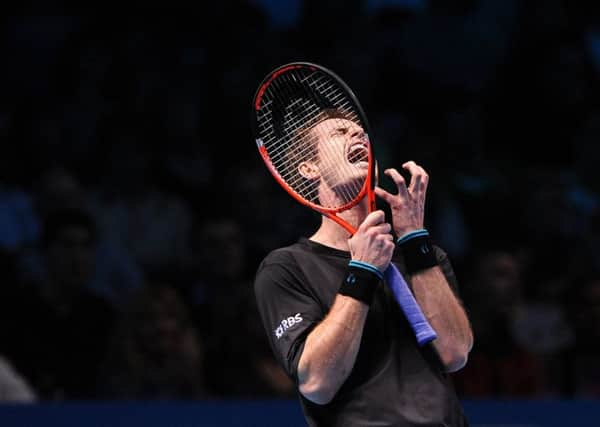Years of high intensity tennis have taken toll on Andy Murray


This was planned to be the tournament where the 30-year-old would confirm his return to competitive tennis after a worrying spell of inactivity and in good time for the Australian Open, which begins a week on Monday.
The Scot last featured in a competitive match when losing from two sets to one up against Sam Querrey in the last eight at Wimbledon. Even then he was unable to conceal problems associated with a hip problem that now, he admits, could require surgery. It’s a worrying, potentially career-threatening development.
Advertisement
Hide AdAdvertisement
Hide AdHe isn’t alone in such a plight, of course. Novak Djokovic recently withdrew from a tournament in Doha where he was expecting to make his long-awaited comeback after elbow trouble. The continuing problems of two such high-profile players helps raise concerns about the intense schedule in both men’s and women’s tennis.


Stan Wawrinka has delayed his return after knee surgery and Rafael Nadal also withdrew from the Brisbane International after retiring from the ATP Finals in London in November. The Spaniard is trying to overcome problems with his right knee.
Gabrine Mugaruzza, meanwhile, saw her Brisbane involvement cut short yesterday after collapsing during her match against Aleksandra Krunic. It’s the fourth time in four years she has pulled out of this particular tournament, although heat rather than illness or injury appears to have been the principal factor on this latest occasion.
But Murray’s predicament along with the long, heartfelt message posted on social media yesterday is causing particular concern. His high intensity style always anticipated such problems being stored up later in his career. There can be no surprise if more than a dozen years scrapping for major titles in the most competitive era men’s tennis has known have taken a toll. His haul of three grand slams, two Olympic singles golds and a Davis Cup title won along with his Great Britain colleagues can be viewed as an outstanding return, particularly since it includes two Wimbledon triumphs. He will have turned 31 before he’s next due to compete at SW17. He’s already voiced a desire simply to be competitive when he returns.
No one should interpret Murray’s recent problems, or indeed yesterday’s less-than- positive New Year message, as signalling the end. It does not necessarily even presage such a distressing event (although it has to come some time, perhaps sooner rather than later).


But his words – all 384 of them – throw up enough doubt to wonder if he can possibly be the same player again, particularly if he is forced to undergo the surgery he has been trying to resist for so long. Murray conceded he is currently “reassessing” his options. The photograph he chose to illustrate his words on Facebook and Instagram was interesting. It was from when he was a pupil at Dunblane Primary school rather than a more recent and perhaps routine one of him in action. He explained it reminded him of the little kid who just wanted to play tennis from dawn to dusk – and, crucially perhaps, was physically able to do so.
But it also invited others to delve more deeply. Some were interpreting his post as a postcard to a boy who was sustained by a love of tennis itself. Murray appears to long for a time when playing was a passion rather than a chore and before he was trapped on the hamster wheel of demands that is an obligation of professional tennis.
“I choose this pic as the little kid inside me just wants to play tennis and Compete. I genuinely miss it so much and I would give anything to be back out there,” the Scot wrote. “I didn’t realise until these last few months just how much I love this game. Every time I wake up from sleeping or napping I hope that it’s better and it’s quite demoralising when you get on the court it’s not at the level you need it to be to compete at this level.”
Advertisement
Hide AdAdvertisement
Hide AdThere’s not much in this from which to extract too much optimism. His entire 2017, a year he began ranked at No 1, was torpedoed by injury concerns, stretching back to last February when he was diagnosed with shingles of all things after exiting the Australian Open. He pulled out of the Miami Open due to an elbow problem and overcame a cough and heavy cold to reach the last four at the French Open.
Brad Gilbert, his former coach, believes it would involve a “long recovery back” if Murray feels he has no choice but to opt for surgery, particularly given how much tennis he has missed already.
Sue Barker recently voiced her concerns for the welfare of players locked into such a gruelling schedule and predicted more players will pick and choose tournaments in which to partake, as Roger Federer, pictured left, has been doing. “These players are playing at such a level now, physically, that I just don’t think it’s possible for them to do the calendars that they’re doing,” the presenter and former French Open champion said.
Federer’s case does provide grounds for hope. While clearly a different player to Murray, the Swiss benefitted from a long injury-enforced break, winning last year’s Australian Open after a six-month lay-off. Even now, when well into the second-half of his 30s, he remains a serious contender and starts this year ranked at No 2.